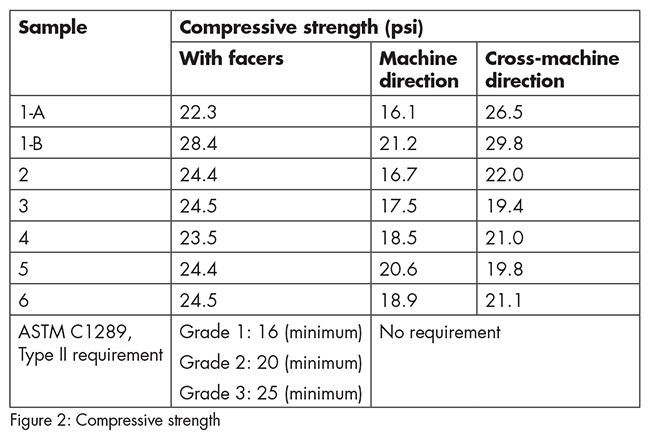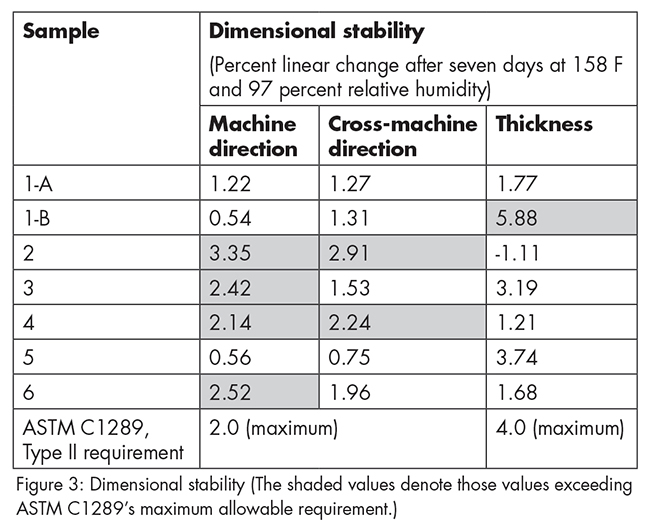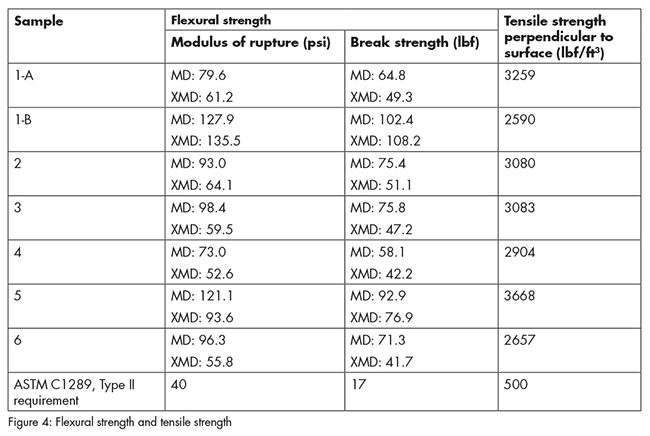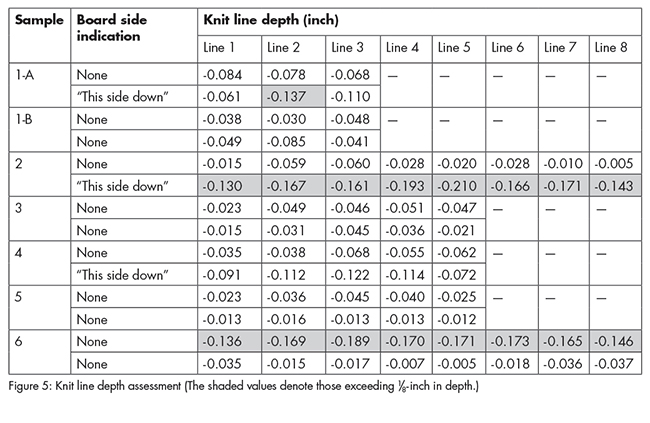In late 2015, NRCA conducted physical property testing on a limited number of samples of new (uninstalled) faced, rigid board polyisocyanurate insulation used as components of low-slope roof systems.
The purpose was to determine the samples' compliances with the U.S. product standard for polyisocyanurate insulation, ASTM C1289, "Standard Specification for Faced Rigid Cellular Polyisocyanurate Thermal Insulation." The results also provide a basis for comparison with previous testing conducted by NRCA in 2002 and 2009.
ASTM C1289
ASTM C1289 describes methods for testing faced polyisocyanurate insulation's physical properties and R-values and provides consensus-based minimum or maximum values for the properties tested. For example, ASTM C1289's Section 11—Test Methods indicates dimensional stability testing shall be conducted using ASTM D2126, "Test Method for Response of Rigid Cellular Plastics to Thermal and Humid Aging," except each test specimen shall be 12 inches by 12 inches by the full-faced board thickness. ASTM C1289's Table 1-Physical Properties prescribes maximum dimensional stability values of 2 percent linear change in a board's length and width and 4 percent linear change in a board's thickness.
ASTM C1289 also provides prescriptive requirements addressing polyisocyanurate insulation's dimensional tolerances, face trueness and package marking.
Previous NRCA testing
NRCA previously conducted similar physical property test programs on faced, rigid board polyisocyanurate insulation in 2002 and 2009. Data from these test programs provide a basis for comparing results from NRCA's current test program with its previous test programs.
Results from NRCA's 2002 test program are characterized by relatively high compressive strength and dimensional stability values in a board's thickness though only one sample exceeded ASTM C1289's 4 percent allowable linear change limit in a board's thickness.
Some products included in NRCA's 2002 test program are now known to have been manufactured using the then-common HCFC-141b blowing agent while other products were manufactured using the next generation hydrocarbon- (pentane-) based blowing agents. Because Dec. 31, 2002, marked a federally mandated deadline for ceasing production of HCFC-141b, polyisocyanurate insulation manufacturers were in a period of transitioning blowing agents during the time NRCA collected polyisocyanurate insulation board samples for its 2002 test program.
All the products included in NRCA's 2009 test program are believed to have been manufactured using hydrocarbon-based blowing agents, the same general class of blowing agent currently used for products.
Results from NRCA's 2009 test program are characterized by relatively high compressive strength values and a range of dimensional stability values. One sample tested exceeded ASTM C1289's 2 percent allowable linear change limit in the cross-machine direction, and two samples exhibited shrinkage in board thickness.
2015 testing and results
NRCA obtained seven multiple-board samples of newly manufactured (uninstalled) 2-inch-thick, permeable facer-sheet-faced polyisocyanurate insulation made by six U.S. manufacturers. The samples were obtained from NRCA contractor members throughout the U.S. from their stored stocks.
Samples 1-A and 1-B were manufactured by the same manufacturer. Sample 1-A is faced with Class 1 fiberglass-reinforced cellulosic felt facers, and Sample 1-B is faced with Class 2 coated polymer-bonded fiberglass mat facers. Samples 2, 3, 4 and 6 were manufactured from four manufacturers using Class 1 facers. Sample 5 was manufactured by a different manufacturer using Class 2 facers. All U.S. manufacturers of rigid board polyisocyanurate insulation are represented in the sampling.
The samples were provided to a nationally recognized testing laboratory, Structural Research Inc. (SRI), Middleton, Wis., for testing and analysis. A minimum of five specimens per sample were subjected to testing for the samples' compressive strength, dimensional stability, flexural strength and tensile strength properties using the methods defined in ASTM C1289.
The samples' densities also were determined; density measurement is not part of ASTM C1289.
Measured apparent overall density (including the facer sheets) and apparent foam core density values for each of the samples are shown in Figure 1. The values reported in the figures are the per sample averages for the multiple specimens tested.

|
The difference between a sample's apparent overall density and apparent foam core density is an indication of the relative mass of the foam's facers (top and bottom facers). Although Samples 1-B and 5 (the samples with coated fiberglass facers) have notably higher apparent densities than other samples, their apparent foam core densities are similar to the cellulosic felt-faced samples.
Apparent foam core density values in NRCA's 2015 test program are similar to those from its 2009 testing and slightly lower than those in the 2002 testing.
Tested compressive strength values for each of the samples are shown in Figure 2. All the samples tested comply with ASTM C1289's Grade 2 designation, meaning they have a 20-psi minimum compressive strength. Sample 1-B also complies with ASTM C1289's Grade 3 designation (25-psi minimum compressive strength).

|
Compressive strength values with facers in the 2015 test program are notably lower than those from NRCA's 2002 and 2009 testing.
Tested dimensional stability values for each of the samples are shown in Figure 3. Only Samples 1-A and 5 comply with the maximum percent linear change allowable limit in ASTM C1289. Samples 2, 3, 4 and 6 exceed the allowable limit in the machine direction (MD); Samples 2 and 4 also exceed the allowable limit in the cross-machine direction (XMD). Sample 1-B exceeds the allowable limit in the sample's thickness.

|
Dimensional stability values in the 2015 test program are notably higher than those in NRCA's 2002 and 2009 testing. From NRCA's 2002 and 2009 testing, only one sample failed to comply with ASTM C1289's dimensional stability limits. In the 2015 test program, five of the seven did not comply.
Tested flexural strength, modulus of rupture, break load and tensile strength perpendicular to the surface for each of the samples are shown in Figure 4. All the samples have tested values well in excess of ASTM C1289's minimum requirements. Samples 1B and 5 (the samples with coated fiberglass facers) have somewhat higher modulus of rupture and break strength values than the samples with cellulosic felt facers.

|
Modulus of rupture and break strength values in NRCA's 2015 test program are slightly lower than those from the 2002 and 2009 testing. Tensile strength values are similar in all three test programs.
Knit line assessment
Linear surface depressions, or rutting, sometimes is associated with smooth-surfaced membrane roof systems, particularly single-ply membrane roof systems applied directly over faced, rigid board polyisocyanurate insulation. An example of this condition is shown in the photo.
Field investigations and test cuts reveal such rutting typically correlates to linear depressions occurring on the flat surfaces of polyisocyanurate insulation. These depressions align with knit lines that occur through the foam's cross-sectional thickness. Multiple knit lines occur in the foam's machine direction as a result of streams of liquid foam spreading and rising between mix heads during manufacturing. The number and spacing of knit lines per polyisocyanurate insulation board may vary by manufacturer and plants based on the number of mix heads and liquid streams used in a particular manufacturing line.
To assess the surface depressions associated with faced, rigid board polyisocyanurate insulation's knit lines, NRCA asked SRI to record the number of knit lines and measure knit line depths on each of the samples included in NRCA's 2015 test program (see Figure 5).
ASTM C1289 neither specifically addresses knit line depressions in polyisocyanurate insulation nor provides allowable maximum knit line depression tolerances. Relating to surface variability, ASTM C1289's Section 8.1—Dimensional Tolerances indicates "… the thickness tolerance shall not exceed 1/8 in. (3.2 mm), and the thickness of any two boards shall not differ more than 1/8 in. (3.2 mm). …" Section 8.5—Face Thickness indicates "… boards shall not depart from absolute flatness more than 1/8 in./ft. (10 mm/m) of length and width." Section 8.7—Crushings and Depressions indicates "… boards shall have no crushed or depressed areas on any surface exceeding 1/8 in (3.2 mm) in depth on more than 10% of the total surface area."

|
In Figure 5, measured values in excess of 1/8 of an inch (0.125 in.) are highlighted. NRCA considers this value to be excessive, particularly for adhered, single-ply membrane roof systems. Possible pooling of adhesives in these depressions during application, bridging of the membrane over the depressions and the rutted finished membrane surface appearance are among NRCA's concerns.
Closing thoughts
NRCA's Technical Operations Committee has overseen and reviewed the results of NRCA's 2015 testing of faced, rigid board polyisocyanurate insulation.
The results show some variability in faced, rigid board polyisocyanurate insulation products; instances where specific physical property values do not fall within ASTM C1289's allowable limits; and instances where values have noticeably changed from NRCA's previous testing in 2002 and 2009. NRCA acknowledges the sampling used in this program may not be statistically representative of all polyisocyanurate insulation currently being manufactured.
The test program's findings regarding dimensional stability are of specific concern. NRCA first raised this issue specific to faced, rigid board polyisocyanurate insulation during the mid-1990s. The 2002 and 2009 testing showed some improvements in polyisocyanurate insulation's dimensional stabilities, but NRCA's 2015 testing shows dimensional stability issues are recurring with newly manufactured products and the magnitude of the issues is equal to or greater than in the 1990s. This finding also is consistent with field reports NRCA's Technical Services Section is receiving.
In addition, the issue of surface depressions associated with knit lines in faced, rigid board polyisocyanurate insulation is of particular concern. Although this problem was previously seen only in isolated instances, it now appears to be more pronounced and widespread with the current generation of polyisocyanurate insulation blowing agents and manufacturing processes. Polyisocyanurate insulation manufacturers need to improve the flatness of their roofing-specific products, and appropriate evaluation criteria need to be developed and included in ASTM C1289.
Until these issues are adequately addressed, NRCA maintains its longstanding recommendation to roof system designers for use of a suitable cover board over faced, rigid board polyisocyanurate insulation. Additional information regarding polyisocyanurate insulation and NRCA's cover board recommendations are provided in The NRCA Roofing Manual: Membrane Roof Systems—2015.
NRCA looks forward to working constructively with polyisocyanurate insulation manufacturers at ASTM International and elsewhere in the roofing industry to address these issues.
Mark S. Graham is NRCA's vice president of technical services.



